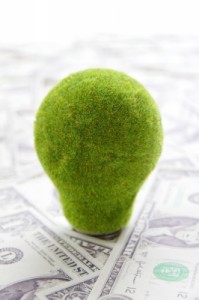 There are many reasons why a person decides to go green, and there are just as many ways. However, it always seems that going green and being environmentally friendly is more expensive than not. While there are some expensive products that can make you have the greenest house on the block, there are other cheaper ways you can go green. There are small things you can do day-to-day to reduce your carbon footprint, as well as some inexpensive quick fixes and systems that you can use to help you stay green.
There are many reasons why a person decides to go green, and there are just as many ways. However, it always seems that going green and being environmentally friendly is more expensive than not. While there are some expensive products that can make you have the greenest house on the block, there are other cheaper ways you can go green. There are small things you can do day-to-day to reduce your carbon footprint, as well as some inexpensive quick fixes and systems that you can use to help you stay green.
One of the easiest ways to keep your home eco-friendly is by sealing up any gaps or spaces around doors and windows. You should look and feel around your doors and windows to see if there are any holes or air leaks. If you find any, you can add some weather stripping around the door or window frame. Also check your windows on the outside to see if any of the calking needs to be replaced. Sealing even the smallest holes helps prevent air from leaking in or out of your house, and can help keep your energy bills lower. Something that people don’t normally think about when it comes to sealing their home is sealing the electrical outlets and light switches. An outlet on an outside wall can allow for extra air to come through. The easiest way to seal your outlets or light switch plates is by using low flow foam around exposed edges, then covering it with a foam and plastic cover. For a complete guide on how to seal your outlets and electrical plates, here is a how to video.
Replacing your light bulbs may seem like a hassle, but when you replace it with an energy saving light bulb you can easily reduce your energy bill and have lights that last longer. In order to light up, normal light bulbs produce a lot more heat, compared to energy-efficient bulbs, which means they use more energy. There are several different types of energy efficient and affordable light bulbs; there are halogen incandescent bulbs, Compact Fluorescent light bulbs (CFL), and Light-emitting diode (LED) bulbs. Halogen Incandescent lights use concentrated halogen gas to light the inside of the bulb and use less energy in the process. CFL bulbs are like normal fluorescent lights but in the form of a small light bulb for lamps and ceiling fans. LED bulbs can be pricey at times, but will also last a lot longer than a normal light bulb would. By changing out your normal light bulbs with an energy-efficient one will help cut down on costs on your electric bill, and reduce the amount of energy used in your household, even if you forget to turn off the light when you’re late for work.
Recycling and reusing is a great way to help the environment. One way to do this is by creating your own composting bins. You can do this with a simple trashcan that has a locking lid and a screwdriver. Composting is a natural way to recycle decomposed organic material, like coffee grounds, fruits and vegetables, or even yard clippings, into your own yard or gardening. In order to compost, you don’t need a fancy compactor; you can make your own compost bin. By composting your organic left overs, you can help reduce the amount that gets thrown into landfills. A great way to use your compost is in your yard or garden. Compost acts as a great fertilizer and will give you richer soil letting, you grow bigger and better plants and produce. It can also help act as an insect repellant.
Another way to recycle and reuse is by reusing your water. There are many people who collect rain water, or even fix their drains so it will catch drain water. Once the water has been caught they are able to use it a second time for plants or other things, and then they can use it a third time as toilet water. This is an extreme way to save and reuse water, but does help reduce the amount of water used. If you don’t want to set up your own water recycling system, you can opt to get a whole house water filter system. This lets you reduce the amount of chemicals and sediments in your tap water anywhere in your home. Without these sediments and chemicals in your water, you can prolong the life of your appliances like your water heater, dishwasher, and washing machine. Most whole house water filters create no water waste or use a lot of energy to run, meaning it can save you on your electric bill and helps reduce the about of water waste.
These are just a couple of ways you can make your home environmentally friendly without breaking the bank. Some more ways to help you go green and save some money are turning lights off, unplugging electronics at the wall, and turning the water off when brushing your teeth. Being environmentally friendly can be very easy and cost effective. With these small changes and improvements, you may find that not only are you helping the environment, but your electric and water bills may actually be lower.
Do you do anything to make your home green?


Some great tips. We use both a rain barrel and a compost bin both of which are in our back yard. This has helped us cut back on water usage thus lowering the costs. The compost bin has given us nice nutrient rich soil free of charge and has saved us money but not having to purchase green bags. Great post. Mr.CBB